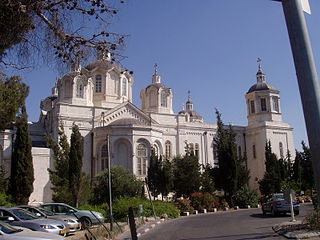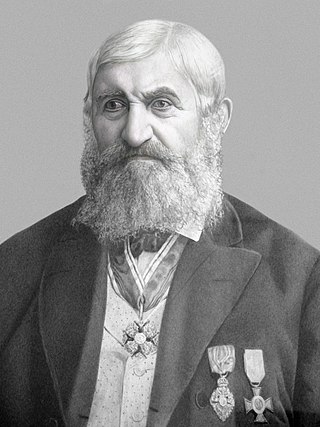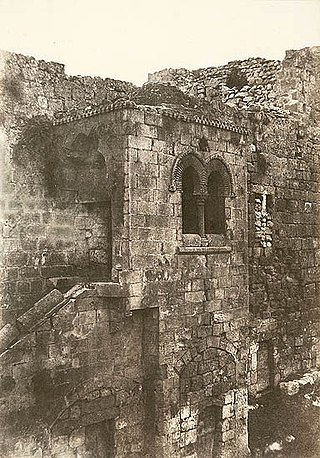

Conrad Schick Library is a small research library located at the Christ Church, in Jerusalem. [1]


Conrad Schick Library is a small research library located at the Christ Church, in Jerusalem. [1]
Established in 2007, the library is named in honor of the German missionary Conrad Schick, who was an architect, Jerusalem's first town planner and an important early archaeologist. Schick was employed by the Church's Ministry Among Jewish People from 1850 until his death in 1901 and many of those years he worked at Christ Church. The library has a number of Schick's architectural plans as well as some personal correspondence. Christ Church owns three of his large models: The Christian Quarter, the Holy Sepulchre and the Temple Mount.
The library specializes in Evangelical Christian involvement in the modern Middle East; specifically in the field of politics, education, medical work and the exploration of the Holy Land. It also holds a number of letters, papers and journals connected with the local philanthropic activities of the LJS, including the establishment of clinics and the English Mission Hospital in 19th-century Palestine. [2] This includes the records of Christ Church Jerusalem, the oldest Protestant Church in the Middle East, along with material about LJS hospitals, mission stations, schools, book depots and workshops. Other core subject areas include the work of the London Jews' Society in other countries such as Ethiopia and Eastern Europe. The origins and growth of the Messianic Jewish movement, Arab Anglicanism and the scholarly study of Protestant eschatology are also areas of interest for the library. It also houses early 19th-century maps of Jerusalem, the partial archive of the Palestine Exhibition and 6,000 glass slides mostly of Palestine in the late 19th and early 20th centuries.
The library is housed in the building that was the first British Consulate in Jerusalem, and later used as a school. It is open by appointment to university students, licensed guides and researchers. The Conrad Schick Library also serves visiting clergy studying Biblical subjects and the Jewish roots of Christianity at Christ Church.

Christian Zionism is an ideology that, in a Christian context, espouses the return of the Jewish people to the Holy Land. Likewise, it holds that the founding of the State of Israel in 1948 was in accordance with Bible prophecy: that the re-establishment of Jewish sovereignty in the Levant — the eschatological "Gathering of Israel" — is a prerequisite for the Second Coming of Jesus Christ. The term began to be used in the mid-20th century, in place of Christian restorationism, as proponents of the ideology rallied behind Zionists in support of a Jewish national homeland.

The Church of All Nations, also known as the Church of Gethsemane or the Basilica of the Agony, is a Roman Catholic church located on the Mount of Olives in East Jerusalem, next to the Garden of Gethsemane. It enshrines a section of bedrock where Jesus is said to have prayed before his arrest.

Beit Jala is a Palestinian Christian town in the Bethlehem Governorate of Palestine, in the West Bank. Beit Jala is located 10 km (6.2 mi)10 km south of Jerusalem, on the western side of the Hebron road, opposite Bethlehem, at 825 meters (2,707 ft) altitude. In 2017, Beit Jala had 13,484 inhabitants according to the Palestinian Central Bureau of Statistics. About 80% of the population were Christians and about 20% Muslims.

The Greek Orthodox Patriarchate of Jerusalem, also known as the Greek Orthodox Church of Jerusalem, is an autocephalous church within the wider communion of Eastern Orthodox Christianity. Established in the mid-fifth century as one of the oldest patriarchates in Christendom, it is headquartered in the Church of the Holy Sepulchre in Jerusalem and led by the patriarch of Jerusalem, currently Theophilos III. The patriarchate's ecclesiastical jurisdiction includes roughly 200,000 to 500,000 Orthodox Christians across the Holy Land in Palestine, Jordan and Israel.

The AnglicanDiocese of Jerusalem is the Anglican jurisdiction for Israel, Palestine, Jordan, Syria and Lebanon. It is a part of the Episcopal Church in Jerusalem and the Middle East, and has diocesan offices at St. George's Cathedral, Jerusalem.

The Garden Tomb is a Christian pilgrimage site in Jerusalem that contains an ancient tomb, also named the Garden Tomb, considered by some Protestants to be the empty tomb whence Jesus of Nazareth resurrected. This belief contrasts with an older tradition according to which the death and resurrection of Jesus occurred at a site known as the Church of the Holy Sepulchre. The Garden Tomb is adjacent to a rocky knoll known as Skull Hill. In the mid-nineteenth century, some Christian scholars proposed that Skull Hill is Golgotha, where the Romans crucified Jesus. Accordingly, the Garden Tomb draws hundreds of thousands of annual visitors, especially Evangelicals and other Protestants.

The Muslim Quarter is one of the four sectors of the ancient, walled Old City of Jerusalem. It covers 31 hectares of the northeastern sector of the Old City. The quarter is the largest and most populous of the four quarters and extends from the Lions' Gate in the east, along the northern wall of the Temple Mount in the south, to the Damascus Gate—Western Wall route in the west. The Via Dolorosa starts in this quarter.

The Christian Quarter is one of the four quarters of the walled Old City of Jerusalem, the other three being the Jewish Quarter, the Muslim Quarter and the Armenian Quarter. The Christian Quarter is situated in the northwestern corner of the Old City, extending from the New Gate in the north, along the western wall of the Old City as far as the Jaffa Gate, along the Jaffa Gate - Western Wall route in the south, bordering on the Jewish and Armenian Quarters, as far as the Damascus Gate in the east, where it borders on the Muslim Quarter.

The Russian Compound is one of the oldest districts in central Jerusalem, featuring a large Russian Orthodox church, the Russian-owned Sergei's Courtyard and the premises of the Russian Consulate General in Jerusalem, as well as the site of former pilgrim hostels, some of which are used as Israeli government buildings, and one of which hosts the Museum of Underground Prisoners. The compound was built between 1860 and 1890, with the addition in 1903 of the Nikolai Pilgrims Hospice. It was one of the first structures to be built outside the Old City of Jerusalem. The Bezalel Academy of Arts and Design's main campus is adjacent to the compound.

Jerusalem's role in first-century Christianity, during the ministry of Jesus and the Apostolic Age, as recorded in the New Testament, gives it great importance, both culturally and religiously, in Christianity. Jerusalem is generally considered the cradle of Christianity.

The Muristan is a complex of streets and shops in the Christian Quarter of the Old City of Jerusalem. The site was the location of the first Bimaristan of the Knights Hospitaller.
The Church's Ministry Among Jewish People (CMJ) is an Anglican missionary society founded in 1809.

The Lutheran Church of the Redeemer is the second Protestant church in Jerusalem. It is a property of the Evangelical Jerusalem Foundation, one of the three foundations of the Evangelical Church in Germany (EKD) in the Holy Land. Built between 1893 and 1898 by the architect Paul Ferdinand Groth following the designs of Friedrich Adler, the Church of the Redeemer currently houses Lutheran congregations that worship in Arabic, German, Danish, and English. The Church, together with the adjoining provost building, is the seat of the Provost of the German Protestant Ministries in the Holy Land. It also serves as the headquarters of the Bishop of the Evangelical Lutheran Church in Jordan and the Holy Land, since this Arabic-speaking (Palestinian) church became independent from the German provost in 1979.

Conrad Schick (1822–1901) was a German architect, archaeologist and Protestant missionary who settled in Jerusalem in the mid-nineteenth century. For many decades, he was head of the "House of Industry" at the Christ Church, which was the institute for vocational training of the London Society for Promoting Christianity Amongst the Jews.

Christ Church, Jerusalem, is an Anglican church located inside the Old City of Jerusalem, established in 1849 by the London Society for Promoting Christianity Amongst the Jews. It was the original seat of the Anglican Bishop in Jerusalem until the opening of St. George's Cathedral, Jerusalem in 1899; the compound also included the 19th century British Consulate. From its inception, Christ Church has been supporting a form of Christianity focused on Jesus' Jewishness, offering Christian texts translated into Hebrew by its own leaders.

Street of the Prophets is an east–west axis road in Jerusalem beginning outside Damascus Gate and ending at Davidka Square. Located to the north of Jaffa Road, it bisects the neighborhood of Musrara.
The Evangelical Lutheran Church in Jordan and the Holy Land (ELCJHL) is a Lutheran denomination that has congregations in Jordan and State of Palestine. First recognized as an autonomous religious community by King Hussein in 1959, the church currently has 2,500 members in six congregations.
John Zeller (1830–1902), also known by his German name Johannes Zeller, was a 19th-century Protestant missionary in Ottoman Palestine. Zeller's four decades left a lasting impact in the areas of Protestant Christianity, scholarship, and education.

The Church of Saint Mary of the Latins was a church building in the Old City of Jerusalem in the Crusader Kingdom of Jerusalem.

The Schick models of Jerusalem are notable wooden models of buildings and areas in the city of Jerusalem constructed by Conrad Schick in the late 19th century. The series of models covered the Church of the Holy Sepulchre, the Islamic buildings of Al-Aqsa on the Temple Mount and the terrain beneath it, as well as replicas of the Jewish Temple based on the information available in his time, and benefitting from his architectural knowledge.